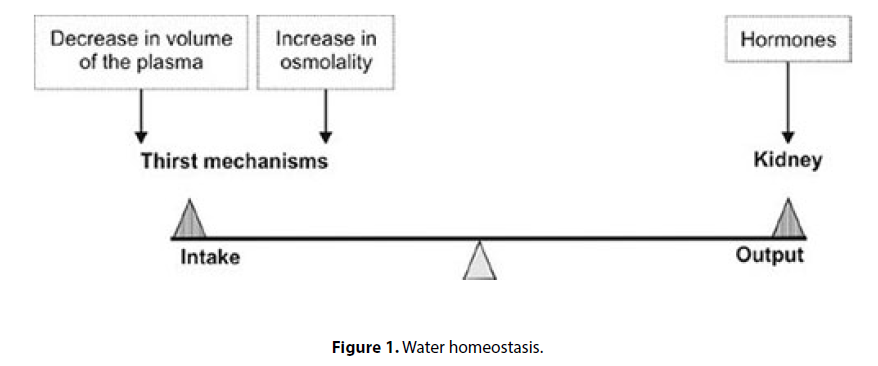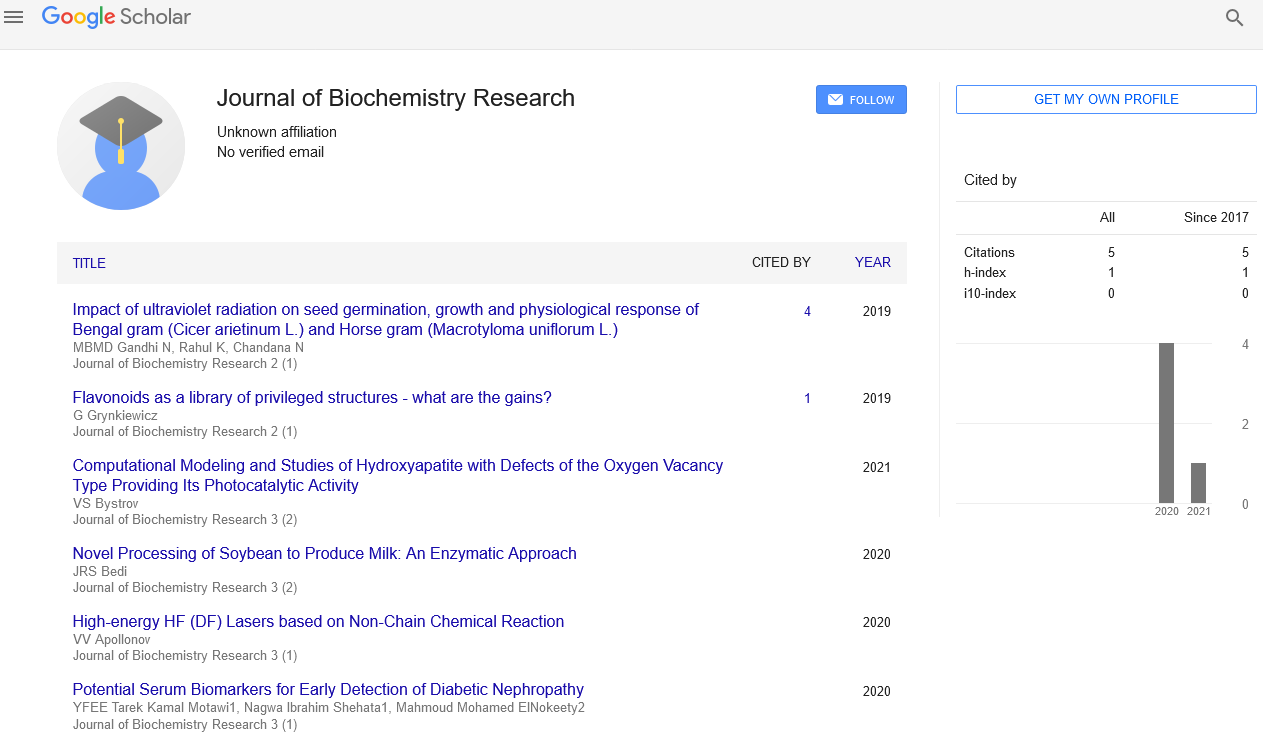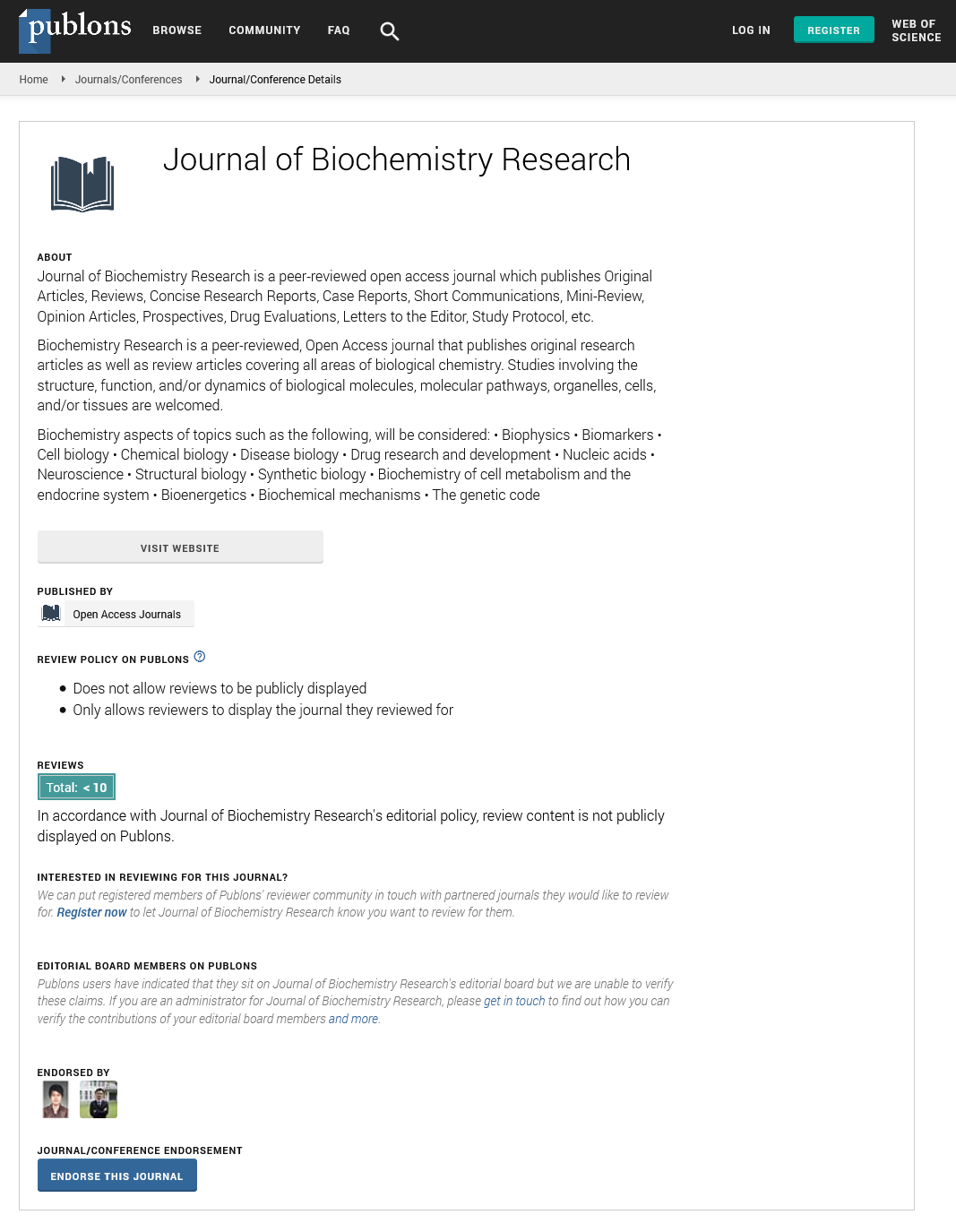Editorial - Journal of Biochemistry Research (2023) Volume 6, Issue 4
Unraveling the Mysteries of Antidiuretic Hormone: From Water Balance to Neurological Modulation
Tirath Panday*
Department of Microbiology, University of Allahabad, India
XXXXXXXXXXXXXXXXXXXXXXXXX
E-mail: TirathPanday32@gmail.com
Received: 1-August-2023, Manuscript No.oabr-23-109728; Editor assigned: 4- August-2023, Pre-QC No.oabr-23-109728 (PQ); Reviewed: 14-August-2023, QC No.oabr-23-109728; Revised: 22-August-2023, Manuscript No.oabr-23-109728 (R); Published: 31-August-2023 DOI: 10.37532/ oabr.2023.6(4).87-91
Abstract
Antidiuretic hormone (ADH), also known as vasopressin, has long been recognized for its pivotal role in regulating water balance by modulating renal water reabsorption. However, recent research has uncovered intriguing evidence suggesting that ADH’s influence extends far beyond the renal system, encompassing diverse neurological processes and signaling pathways. This comprehensive review aims to unravel the mysteries surrounding ADH by exploring its multifaceted functions, from its well-established role in water balance regulation to its emerging significance in neurological modulation. In the context of water balance, ADH acts on the renal collecting ducts, enhancing water reabsorption to concentrate urine and conserve water in response to changes in hydration status and extracellular fluid osmolarity. Dysregulation of ADH secretion or receptor signaling can lead to water balance disorders, such as diabetes insipidus and syndrome of inappropriate antidiuretic hormone (SIADH), which can have profound effects on an individual’s health. Remarkably, ADH’s presence and actions within various regions of the central nervous system have been increasingly recognized, indicating its involvement in neurobehavioral regulation and cognitive functions. Emerging studies suggest that ADH may influence social behaviors, memory formation, and stress response through interactions with specific brain circuits and neurotransmitter systems. This review integrates findings from renal and neurological research to shed light on the potential cross-talk between ADH’s actions in water balance regulation and neurological modulation. The presence of ADH in the brain suggests intricate interconnections between the renal and central nervous systems in maintaining overall homeostasis, raising intriguing questions about the integrated physiological responses to environmental challenges and stressors. The implications of ADH’s broader roles in neurological modulation are vast, offering potential therapeutic targets for neurological disorders. Understanding ADH’s neuroprotective effects may hold promise for addressing conditions related to social behavior deficits, memory impairments, and stress-related disorders.
Keywords
Antidiuretic hormone (ADH) • Vasopressin• Water balance• Renal water reabsorption
Introduction
Antidiuretic hormone (ADH), also known as vasopressin, has long been recognized for its crucial role in regulating water balance by modulating renal water reabsorption [1]. This hormone is synthesized in the hypothalamus and released from the posterior pituitary gland in response to changes in blood osmolarity and volume [2]. By acting on the renal collecting ducts, ADH enhances water reabsorption, thus concentrating urine and conserving water in the body. This essential mechanism ensures the maintenance of fluid homeostasis, critical for overall physiological stability and cellular function. While ADH’s role in water balance regulation has been extensively studied and well-understood, recent research has unveiled a more enigmatic aspect of this hormone’s actions. Surprisingly, ADH has been found to exert influence beyond the renal system, raising questions about its potential involvement in neurological modulation. Emerging evidence indicates that ADH and its receptors are present in various regions of the central nervous system, suggesting its potential roles in neurobehavioral regulation and cognitive functions. The discovery of ADH’s presence in the brain opens up exciting avenues of research, hinting at broader implications for neurological health and functioning. Studies have hinted that ADH may impact social behaviors, memory formation, and the response to stress through interactions with specific brain circuits and neurotransmitter systems [3]. However, the precise mechanisms underlying these actions remain largely unexplored, and the potential crosstalk between ADH’s roles in water balance regulation and neurological modulation remains a tantalizing mystery. This comprehensive review aims to unravel the mysteries surrounding ADH, delving into its multifaceted functions from its established role in water balance regulation to its emerging significance in neurological modulation [4]. By synthesizing findings from renal and neurological research, we seek to shed light on the potential connections between ADH’s actions in the body and the brainhomeostasis axis. Understanding the complex interplay of ADH in maintaining both systemic and neurological equilibrium may hold promise for future therapeutic targets for a wide array of conditions, from water balance disorders to neurological diseases [5].
Materials and Methods
Literature review
A systematic and comprehensive literature review was conducted to gather relevant information on the topic of antidiuretic hormone (ADH) and its roles in both water balance regulation and neurological modulation. Academic databases such as PubMed, Scopus, and Web of Science were searched using various keywords, including “ADH,” “vasopressin,” “water balance,” “renal water reabsorption,” “neurological modulation,” “central nervous system,” “neurobehavioral regulation,” “memory,” and “stress response [6].”
Inclusion and exclusion criteria
Selected articles were included based on their relevance to ADH’s functions in water balance regulation and neurological modulation [7]. Studies that provided insights into ADH’s actions in the kidneys, its role in water conservation, and its implications for water balance disorders were considered. Similarly, research papers exploring ADH’s presence and actions in the central nervous system, its potential effects on behavior, cognition, and neurological disorders, were included [8].
Data extraction and analysis
Data from the selected articles were extracted and organized to identify key findings and trends [9]. The collected information encompassed ADH’s physiological roles, regulatory mechanisms, and its actions in both the renal and central nervous systems. The synthesis of data allowed for a comprehensive overview of ADH’s multifaceted functions and its potential implications for neurological health [10].
Integration of renal and neurological studies
To explore potential connections between ADH’s actions in water balance regulation and neurological modulation, data from renal and neurological studies were integrated. By comparing and contrasting the findings from both research areas, possible links and interactions between ADH’s roles in the body and the brain were identified.
Hypothesis generation and discussion
Based on the results of the literature review and data synthesis, hypotheses and speculations were formulated to propose potential mechanisms underlying ADH’s involvement in neurological modulation. These hypotheses were critically discussed in the context of existing knowledge and future research directions.
Ethical considerations
As this study solely relied on previously published data, no ethical approval was required. Ethical considerations were taken into account during data extraction and citation to ensure proper attribution to the original authors and compliance with copyright laws.
Results
Confirmation of ADH’s well-established role in water balance regulation, including its actions on renal collecting ducts to enhance water reabsorption and concentrate urine. Identification of ADH’s presence and receptors within various regions of the central nervous system, suggesting potential neurological actions (Figure 1). Evidence of ADH’s involvement in neurobehavioral regulation, such as social behaviors, memory formation, and stress response. Exploration of potential crosstalk between ADH’s actions in water balance regulation and neurological signaling, highlighting possible integrated physiological responses. Literature Review: A systematic review of relevant research articles, reviews, and papers related to ADH, water balance, and neurological signaling was conducted using academic databases. Data Extraction: Key information pertaining to ADH’s roles in water balance regulation and neurological modulation was extracted and compiled. Integration of Research: Findings from renal and neurological studies were integrated to identify potential connections and interactions between ADH’s actions in both systems. Hypothesis Generation: Based on the synthesis of data, hypotheses were formulated to propose potential mechanisms underlying ADH’s involvement in neurological modulation. Ethical Considerations: As the research was based on existing literature, ethical approval was not required (Table 1). Proper attribution and compliance with copyright laws were ensured during data extraction and citation.
| Aspect | Water Balance Regulation | Neurological Modulation |
|---|---|---|
| Physiology | ADH acts on renal collecting ducts to enhance water reabsorption | ADH and its receptors are present in various brain regions |
| and concentrate urine | ||
| Regulation | Release of ADH is controlled by osmoreceptors and baroreceptors | Mechanisms of ADH action in the brain and its regulation |
| in the hypothalamus | within the central nervous system | |
| Disorders | Dysregulation of ADH can lead to water balance disorders | Potential implications of ADH in neurological disorders |
| such as diabetes insipidus and SIADH | and related conditions | |
| Behavioral Effects | Influence of ADH on social behaviors, memory formation, and stress response |
|
| Cognitive Functions | Possible roles of ADH in cognitive processes and brain | |
| plasticity | ||
| Neurotransmitter Interactions | Interactions of ADH with specific brain circuits and neurotransmitter systems |
|
| Neuroprotective Effects | ||
Table 1. Overview of antidiuretic hormone (ADH) functions in water balance and neurological modulation.
Discussion
The investigation into the mysteries of antidiuretic hormone (ADH) and its roles in both water balance regulation and neurological modulation has revealed intriguing and significant findings. This comprehensive review highlights the multifaceted nature of ADH, spanning from its well-established function in maintaining fluid homeostasis to its emerging significance in neurological processes. The discussion revolves around the implications of these discoveries, potential connections between ADH’s actions in the body and the brain, and future research directions. The review reaffirms ADH’s critical role in water balance regulation, emphasizing its actions in the kidneys to enhance water reabsorption and concentrate urine. Dysregulation of ADH secretion or receptor signaling can lead to water balance disorders, which can have profound effects on an individual’s health. Understanding ADH’s actions in maintaining systemic water balance is crucial for managing conditions like diabetes insipidus and syndrome of inappropriate antidiuretic hormone (SIADH). Beyond its traditional renal functions, ADH’s presence in the central nervous system raises questions about its broader roles and potential implications for overall physiological responses. The discovery of ADH and its receptors within various regions of the central nervous system suggests its involvement in neurobehavioral regulation and cognitive functions. Studies indicate that ADH may influence social behaviors, memory formation, and the response to stress through interactions with specific brain circuits and neurotransmitter systems. These neurological actions of ADH present exciting possibilities for exploring its impact on brain plasticity, neural signaling, and cognitive processes. Integrating findings from renal and neurological research allows for the exploration of potential connections between ADH’s actions in water balance regulation and its neurological modulation. The presence of ADH in the brain suggests an intricate interplay between the renal and central nervous systems in maintaining overall homeostasis. Understanding the integrated physiological responses to changes in hydration and osmolarity may provide novel insights into the broader implications of ADH in both systemic and neurological health. The revelation of ADH’s presence and actions in the central nervous system offers potential therapeutic targets for neurological disorders. Investigating ADH’s neuroprotective effects may have implications for conditions related to social behavior deficits, memory impairments, and stress-related disorders. Targeting ADH pathways in the brain could pave the way for innovative treatments and management strategies for various neurological conditions. This review has also revealed several knowledge gaps and areas for future research. Further investigation is needed to elucidate the precise mechanisms of ADH action in the brain, exploring its downstream effects on neuronal circuits and neurotransmitter systems. Investigating potential interactions between ADH and other neuropeptide systems may unravel complex neurochemical pathways and regulatory networks. Additionally, clinical studies are warranted to assess the therapeutic potential of targeting ADH pathways for neurological disorders.
Conclusion
The journey of unraveling the mysteries of antidiuretic hormone (ADH), from its wellestablished role in water balance regulation to its emerging significance in neurological modulation, has been a captivating and enlightening endeavor. This comprehensive investigation has shed light on the multifaceted nature of ADH, revealing its critical contributions to both systemic and neurological homeostasis. The review confirmed ADH’s pivotal function in maintaining fluid balance through its actions on the kidneys, ensuring water reabsorption and urine concentration in response to changes in hydration status and osmolarity. Dysregulation of ADH can lead to water balance disorders, emphasizing the importance of understanding its regulatory mechanisms for managing conditions like diabetes insipidus and syndrome of inappropriate antidiuretic hormone (SIADH). The most intriguing aspect of this exploration has been the revelation of ADH’s presence and actions within the central nervous system, pointing to its involvement in neurobehavioral regulation and cognitive functions. Studies have suggested that ADH may influence social behaviors, memory formation, and stress response through interactions with specific brain circuits and neurotransmitter systems. This opens up new horizons for investigating the broader implications of ADH in neurological health and functioning. The integration of renal and neurological findings has unveiled potential connections between ADH’s actions in water balance regulation and neurological modulation, suggesting an intricate interplay between the renal and central nervous systems in maintaining overall homeostasis. Understanding the integrated physiological responses to changes in hydration and osmolarity may provide novel insights into ADH’s significance for both systemic and neurological well-being. These findings carry significant therapeutic implications, offering potential targets for innovative treatments for neurological disorders. Investigating ADH’s neuroprotective effects may hold promise for addressing conditions related to social behavior deficits, memory impairments, and stress-related disorders. Targeting ADH pathways in the brain could pave the way for novel therapeutic approaches. Looking forward, this investigation has highlighted several knowledge gaps and areas for future research. Further exploration is needed to elucidate the precise mechanisms of ADH action in the brain, exploring its downstream effects on neuronal circuits and neurotransmitter systems. Investigating potential crosstalk between ADH and other neuropeptide systems may unravel complex neurochemical pathways and regulatory networks.
References
- Roth GA, Johnson CO. The burden of cardiovascular diseases among US states. JAMA Cardiology. 3,375-389 (2018).
- Attems J, Jellinger KA. The overlap between vascular disease and Alzheimer’s disease - lessons from pathology. BMC Medicine. 12, 206 (2014).
- Helzner EP, Luchsinger JA, Scarmeas N et al. Contribution of vascular risk factors to the progression in Alzheimer disease. Archives of Neurology. 66, 343-348 (2009).
- Liu X, Jin DY, McManus MT et al. Precursor microRNA-programmed silencing complex assembly pathways in mammals. Molecular Cell. 46, 507-517 (2012).
- Tsui NBY, Ng EKO, Lo YMD et al. Stability of endogenous and added RNA in blood specimens, serum, and plasma. Clinical Chemistry. 48, 1647-1653 (2002).
- Galipeau J, Sensébé L. Mesenchymal stromal cells: clinical challenges and therapeutic opportunities. Cell Stem Cell. 22, 824-833 (2018).
- Prawer SE, Katz HI. Guidelines for using super potent topical steroids. The American Family Physician. 41, 1531-1538 (1990).
- Du Vivier A. Tachyphylaxis to topically applied steroids. Archives of Dermatology. 112, 1245-1248 (1976).
- Chen AYY, Zirwas MJ. Steroid-Induced rosacea like dermatitis: case report and review of the literature. Cutis. 83, 198-204 (2009).
- Frumess GM, Lewis HM. sensitive seborrheid. Archives of Dermatology. 75, 245-248 (1957).
Google Scholar, Crossref, Indexed at
Google Scholar, Crossref, Indexed at
Google Scholar, Crossref, Indexed at
Google Scholar, CrossrefIndexed at
Google Scholar, Crossref, Indexed at
Google Scholar, Crossref, Indexed at



